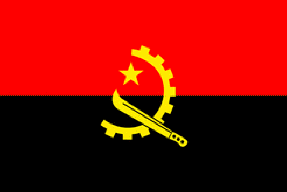Angola


Continent – Africa
Region – Southern Africa
Size – 1,246,700 km²
Geography – Mostly flat plains with a mountainous belt
Language – Portuguese, Bantu, other African languages
Religion – Indigenous 47%, Roman Catholic 38%, Protestant 15%
Monetary Unit – Kwanza
Natural Resources – Petroleum, diamonds, iron ore, phosphate, copper, gold, bauxite, uranium
Agriculture – bananas, sugarcane, coffee, sisal, corn, cotton, manioc (tapioca), tobacco, vegetables, plantains; livestock; forest products; fish
Industry – petroleum; diamonds, iron ore, phosphates, feldspar, bauxite, uranium, and gold; cement; basic metal products; fish processing; food processing, brewing, tobacco products, sugar; textiles; ship repair

Neighbouring Countries – Congo, Zambia, Namibia
Population – 12,263,596 (2007)
Population Growth Rate – 2.2%
Average Life Expectancy – 37.6
Capital City – Luanda (population 2,297,200)
Highest Mountain – Serra Moco (2,610 m)
Longest River – Cubango
Climate – Hot, dry summers 14°C to 32°C and mild winters 8°C to 21°C
Yearly Rainfall – 140 cm approx during the wet season October – March
Plant Life – Different savanna grasses, the far south is home to the tumboa
Animal Life – Leopard, lion, hyena, elephant, hippopotamus, giraffe, zebra, buffalo, wildebeest, antelope, monkey, gorilla, chimpanzee, crocodile
Harvard Reference for this page:
Heather Y Wheeler. (2015). Angola. Available:
https://www.naturalhistoryonthenet.com/Facts_Figures/Country_Facts/angola.htm. Last accessed Monday, July 18, 2016
Facts and Figures Pages
